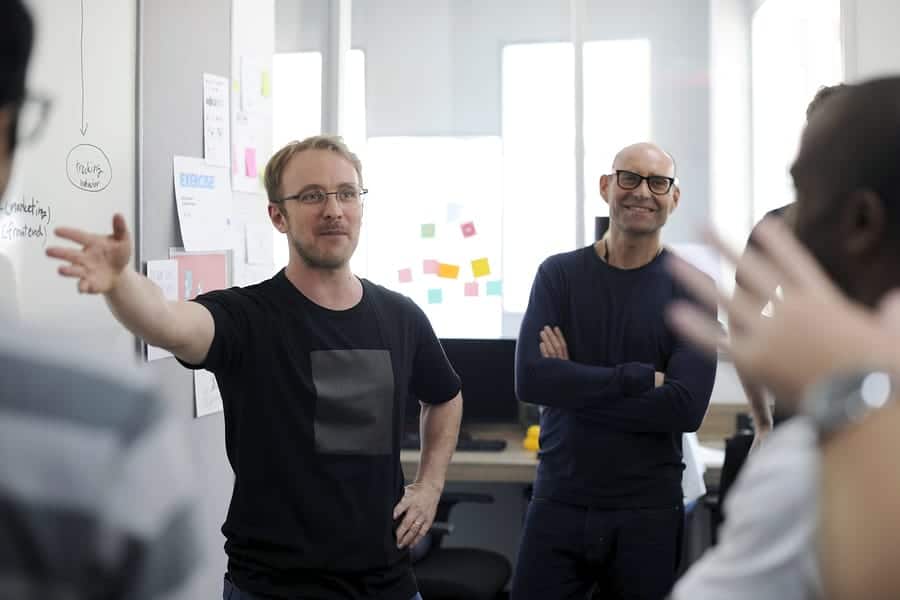A great mobile app product manager is a special type of person: an organizing master, feeling equally at home planning every detail of product strategy months ahead, and improvising in the face of last minute changes. A leader — humble enough to take criticism and learn from their mistakes, but strong enough to stand up when they think management is making the wrong call; a capable and confident communicator, able to bridge the gulf between customers, engineers, investors, and management with ease.

We talked to more than twenty professionals in the mobile app space and other high-tech industries about what it takes to be a top notch digital product manager. Here are three of our favorite answers.
Canva: A Product Manager is a Servant Leader, Not a Dictator
Canva is a freemium design and publishing tool, built to empower a wide range of users to create and share documents, presentations, and more across platforms. Canva users run the gamut from small businesses to large corporations and from teachers to nonprofits. With strong team functionality, an extensive media library, and over 65,000 editable templates, it can serve all types of users with ease.
Canva has a long history, dating back to 2007, when co-founder Melanie Perkins noticed that some of her students at the University of Western Australia had trouble learning to use more traditional design software. She ended up building Fusion Books, an online tool to create yearbooks, along with co-founder Cliff Obrecht. Canva came about because they realized the technology they’d developed for Fusion had many other applications.
It was a long journey, and it gave them plenty of opportunities to learn what it takes to deliver a top-notch product to your users. So it’s no surprise that Shipra Mahindra, Product Manager for Canva’s Mobile team has solid advice for digital product managers. According to Mahindra, a great PM:
1. “Puts users first — i.e. understands that the value is in what gets used, not in what gets built.
2. Ruthlessly prioritizes.
3. Can hustle and inspire their team to deliver.
4. Is a servant leader, not a dictator or manager.”
We like this advice because it succinctly explains the balance effective mobile app product management requires. As Mahindra points out, a good PM is neither a dictatorial micromanager nor a distant leader — they’re a part of the team, working on the ground to make sure their users get the best product possible.

Freight Center: Digital PMs Must Have Emotional Intelligence
Logistics require a steady hand and a cool disposition. You need to be able to coordinate an elaborate network of stakeholders while providing stellar service to demanding customers in spite of inclement weather, changing market conditions, and complex international regulations.
So it’s no surprise that FreightCenter, Inc. ranks emotional intelligence as the most important trait in a product manager. Established in 1998, the logistics company describes itself as an “all-in-one shipping solution service for our customers,” combining exacting customer support with powerful proprietary software to meet a wide range of business and private shipping needs.
Here’s what Terese Kerrigan, Director of Marketing Communications at FreightCenter has to say about the importance of emotional intelligence for product managers:
“Emotional intelligence is a must-have trait: A great product manager is organized and methodical, but above all they have emotional intelligence. This role requires taking pressure from superiors and team members, so critique and praise need to be received with an open mind and communicated in a way that doesn’t derail the project.
A great product manager sees change as an opportunity but also understands when it’s important to say no or not now. Having a knee-jerk reaction to criticism fractures the team, delays release dates and in severe cases produces a failed product.”
We think this is great advice for mobile app product managers. It’s important to look at the total experience and abstract traits like software development methodologies, but a product manager is still a manager. If they can’t handle criticism or keep their perspective in times of rapid change, they can’t serve their team effectively, no matter what skills they possess.
MyPermissions: Breaking Down Problem Solving
Omer Yarkowich gave us such an in-depth and insightful response that it could easily be its own blog post. As VP Products & Marketing at MyPermissions, it’s no surprise he knows his stuff. MyPermissions aims to solve a complex problem that we all face: balancing the benefits of the apps we love with the privacy protections we depend on to keep us safe, secure, and free of unwanted surveillance.

To do that, MyPermissions analyzes apps (3 million to date) to determine what data they collect, how they use it, and empowers users to protect their personal data in their apps and social media. Their most popular app, MyPermissions Privacy Cleaner has helped users avoid data harvesting by Cambridge Analytica and other companies, without having to give up social media.
Here’s what Yarkowich had to say about what makes a great mobile app product manager:
- “Problem Definition – Being able to really, really define (and refine) the problem the product aims to solve. Einstein said that given an hour to solve a problem, he’d dedicate 55 minutes to think of the problem and only the remaining 5 minutes to come up with the solution. Figure out what the problem is that you’re trying to solve and constantly challenge yourself to make sure you’re correctly defining it.
Once you start doing that, you’ll often realize you’ve been trying to solve the wrong problem with the wrong solution. - Consider Your Constraints – Constraints are not a bad thing to have. On the contrary, constraints are beautiful and a crucial ingredient for innovation. Constraints help you focus on the right problem, the right solution, and the right audience.
Constraints also help you come up with new solutions you haven’t considered before. Whether your constraints are budget, talent, or time, you can leverage them to foster innovation in your product (and organization).
Some constraints you’re probably already saddled with without even noticing it are your target audience, market, and even brand. The brand values you wish to emphasize, the tone and voice for your copy and messaging — these are all constraints you impose on yourself.
Once you recognize your constraints, you can make them work for you.
With MyPrivacy, our new product, we decided to take a completely new approach to the way we present our product’s capabilities to our users. Given the average user is not very tech-savvy, we decided to use a user-centric approach and look at the world from our users’ point of view. That triggered a completely new approach to how we need to design the app. If you find yourself without constraints (which I doubt), consider forcing them on yourself. - Leverage Your Existing Assets – Assets are the flip side of constraints, in a way. There’s no better way to get a few quick wins than leveraging your assets to give you an advantage. Email lists, for a new product, are a kind of asset you can use.
The same applies to your talent — do you have someone on your team with a knack for storytelling? Do you have a cousin who’s a travel blogger and can help you spread the word? How about a strong community that can help you crack tough PR challenges? Consider how your current assets can help you solve a problem. - You’re Not Done When You Find the Solution – Finding a solution to your problem at the end of the process may be exhilarating, but products don’t always succeed because you’ve simply found a solution. A great product isn’t just a solution — it’s also a tool that fits neatly into the hands of your customers.”
Consider what your product does — how will it fit into their life? How will they pay for it? Will they continue to use it over time? Will you address their future concerns? Are you committed to delivering a top-notch experience both today and in the future? For an app product manager, the job doesn’t stop when the product launches. You’ve got a long way to go after that point, still.

A Great Mobile App Product Manager Keeps it All Together
Being a great mobile app product manager is about more than just bringing a new app to market. To be successful, you’ve got to have a finger on the pulse of both your prospective users and your team.
If you aren’t in tune to what your users want, you’ll end up wasting your company’s time. On the other hand, if you ignore the capabilities of your team, you’ll be trying to work with unrealistic expectations — leading to burnout, or worse, a failed project.
The ideal app product manager will leverage her team’s skills to tackle specific objectives, assigning the right person to the right task while making sure every user need is accounted for. If anything doesn’t fit, they’ll figure out what can be done about it, and in crunch-time, they’ll keep their team in fighting shape — while still keeping their eye on deadlines.
Proto.io lets anyone build mobile app prototypes that feel real. No coding or design skills required. Bring your ideas to life quickly! Sign up for a free 15-day trial of Proto.io today and get started on your next mobile app design.
Got any great product management tips we missed? Let us know by tweeting us @Protoio!





